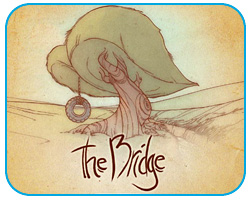
| Spring 2009 Prototype | Arthouse | Adobe Flash (Windows / Macintosh / Linux) |
|
The Bridge is a small game, simple, short. It sneaks up on the player, catches her off guard, toys with convention and makes her wonder: "what is this all about?". It has the charm of a late summer afternoon that is filled with promise and longing...and something dark and dangerous lurking in the shadows of consciousness. The Bridge is a ludic poem, an interactive Zen riddle, open for interpretation, while at the same time portraying a clear and coherent idea. It offers an experience without bells and whistles but with the ring of truth to it. It deals with hope, despair and courage and with the art of letting-go. Artistic Statement Games have become one of the most important expressive media of our time. But since they tend to emphasize fun and instant gratification, their experiential scope is still rather limited. My motivation is to make games that hold a mirror up to life and tackle "the human condition", thus providing powerful, lasting and insightful experiences to players that enhance their understanding of themselves. The Bridge is the second game of a series that attempts this tricky task. It is based on the abstract concept of "emancipation" and uses metaphors to make this process tangible on a cognitive as well as emotional level. It has been inspired by personal experience - the struggle that comes with emotional liberation: giving up the comfort of a familiar but stifling situation, facing one's fears and following one's heart while coping with the prize of this newfound freedom (change - as positive as it may be - is rarely possible without pain). The game models the idea of clinging (i.e. staying within the girl's protective bubble that repels the monsters) and being stuck (charging the girl, walking around with her and rushing back to the tire swing just in time to recharge her again before the monsters attack). It further illustrates how facing one's fears and taking responsibility is the only way out (killing the monsters creates the bridge to the future). The game's rules imply a hopeful message: as long as one keeps struggling, one will succeed. The game can only be lost when the player stops input for 15 seconds when immobilized by the monsters. The Bridge aims to add to the growing canon of games that tackle deep ideas. It is not my ambition that players walk away form this game saying "oh, yes, it is about emancipation". It is my hope, however, that it resonates with them emotionally and that at least fosters some reflection. If players have the feeling they don't get it, that at least means they understand that there is something to get, that there is something beneath the surface. This is the first step to taking games seriously as a medium that can be revelatory of the human condition. - Doris C. Rusch
|
  |
|||||||||
|
Requirements
Screenshots
Developers
Related Publications
Blog Posts
|
||||||||||









